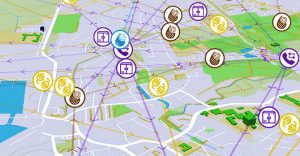Loren Chamberlain, senior product manager, CReDo, explores why systems thinking and a Climate Resilience Demonstrator (CReDo) matter for Critical National Infrastructure
The economy and prosperity of the United Kingdom is intrinsically linked to the robust and efficient operation of the nation’s Critical National Infrastructure (CNI). Storm Arwen in November 2021 demonstrated the significant impacts experienced in response to extreme weather by customers of the power networks, with over a million customers experiencing disruption to their electricity supply. These outages cascaded across sectors and caused failures at water network sites, interrupting water supplies and leaving many without water for several days.

Heatwaves and storms are likely to increase as a result of human-induced climate change
Many factors contribute to the genesis of extreme weather events; however, scientific consensus is that the frequency and intensity of heatwaves and large storms are likely to increase as a result of human-induced climate change. The UK requires new, innovative ways to improve network resilience to climate change forced extreme weather scenarios, particularly focusing on cross-sector impacts, which have previously been difficult to understand.
The CNI in the UK spans many sectors and industries and is interconnected. Connecting data and insights from the real world with models and software is key to understanding the operational status of a network of interconnected assets, how they will be impacted by different climate scenarios and how to make better decisions.
The Climate Resilience Demonstrator (CReDo) is a cross-sector climate adaptation digital twin with the capability to connect data across different utilities and CNI organisations. It is a first-of-a-kind project that demonstrates the power of connected infrastructure information and unlocks brand new understanding of infrastructure interdependencies, helping decision makers to improve asset and network resilience against climate change.
What has the Climate Resilience Demonstrator (CReDo) achieved so far? [H3]
In its 2021-2022 first phase, Climate Resilience Demonstrator (CReDo) demonstrated the value of connecting information across infrastructure sectors. It showed how failures caused by climate change-induced surface water flooding in one sector could cascade through the network and impact assets in other sectors and locations.
Flooding events were simulated over a small area in East Anglia and the digital twin determined which assets in the network would fail due to high water levels. These failures were then propagated through the network to dependent assets further down the chain with a system-wide impact model, capturing the failures from network effects. New insights were unlocked, enabling analysis of previously unmodelled asset interdependencies and understanding how failures can cascade across and between sectors.
For example, a primary power substation could fail due to flooding, resulting in secondary substation power outages, and this could cascade further into the water sector whereby a sewage pump stops functioning even though it was not flooded.
CReDo provides insight into infrastructure interconnectivity
Working with CReDo’s infrastructure partners – Anglian Water, UK Power Networks and BT – we demonstrated that connected digital twins like CReDo provide insight into infrastructure interconnectivity beyond the sum of each network’s parts.
Phase 2 of the CReDo project, concluding at the end of March 2023, is maturing the system into a working prototype that is both scalable and extensible to new asset owners, larger geographical areas, to interoperable datasets and to new climate scenarios. This will enable asset owners to inspect and visualise their own assets and interconnections to other sectors, allowing prediction of failures caused by cross-sector interactions in response to climate flooding simulations. This development is essential as the value unlocked by the system is expected to expand as new asset types and organisations integrate their data securely into the system.
CReDo is paving the way and catalysing new innovations that support strategic planning for future capital investments in climate resilient infrastructure. To achieve this objective and build on the learnings from its first phase, CReDo is developing a distributed data architecture that seeks to maximise the data retained under an individual asset owner’s private systems and security. This is important for retaining data confidentially when dealing with CNI and critical for the future use and adoption of tools like CReDo by infrastructure network operators.
These activities are opening the door for future collaboration with other digital and data initiatives, the possibility to co-develop standards and solutions, and ultimately achieve connected intelligence through an interoperable digital ecosystem. The outcomes from CReDo will be publicly available under permissive licenses to enable other organisations and new sectors to build on existing code, without needing to start from scratch.
Accelerating development and creating capability to plan on a larger scale
There are exciting enhancements conceptualised for the CReDo system and following Phase 2, there will be many opportunities for wider participation in the project beyond the existing network operators, with expansion to new infrastructure types and sectors.
As Connected Places Catapult seeks to gradually hand the system back to the market, interested parties will be able to take a bigger stake in the system’s ongoing development. It’s exciting as these collaborations allow us to accelerate development and create capability to model and plan on a much larger scale, ultimately strengthening our climate resilience and adaptation.
This will help to create collective buy-in and momentum around increasingly connected innovation projects across different infrastructure sectors. This supports our objective at Connected Places Catapult to create an integrated infrastructure innovation ecosystem that supports local, regional, and national opportunity, innovation, and growth.
The CReDo project team is led by Connected Places Catapult and comprises the following organisations and individuals:
– Digital Twin Hub.
– CMCL.
– UKRI STFC (Hartee, DAFNI).
– Sarah Hayes.
– Anglian Water.
– BT.
– UK Power Networks.
– Frontier Economics.
– Academics from: Edinburgh University, Newcastle University, Warwick University and the Alan Turing Institute.
Loren Chamberlain
Senior product manager
CReDo

















